Article
How to Create an Inclusive Culture for LGBTQ+ Patients at the Pharmacy: A Practical Approach
Author(s):
Facilitating environmental cues that members of the LGBTQ+ community look for to signify that they are in a safe space is an especially important element for the LGBTQ+ community.
In the first decade of this century, very little research was conducted on lesbian, gay, bisexual, transgender, and queer (LGBTQ+) health and cultural competency in the United States. However, the second decade brought about a 17-fold increase in published papers. Most of these articles were dedicated to identifying health disparities experienced by the LGBTQ+ community and focused within the profession of nursing, but very few offered solutions to making the workplace more inclusive and welcoming for this population.1
Facilitating environmental cues that members of the LGBTQ+ community look for to signify that they are in a safe space is an especially important element for the LGBTQ+ community. Data on the importance of cues regarding a place being a safe space for LGBTQ+ individuals were highlighted by Healthy People 2010, the third iteration of a national initiative aimed at identifying public health priorities for the next 10 years to help individuals, organizations, and communities across the United States improve health and wellbeing.1
The results of the analysis demonstrated that the health disparities faced by LGBTQ+ individuals include social stigma, denial of civil and human rights, and discrimination, with the latter being associated with an increased rate of psychiatric disorders, substance abuse, and suicide due to its impact on this population.2
LGBTQ+ individuals also experience a high rate of violence and victimization. The coming out process is itself unique to this population, as this process is one that looks for social acceptance of their sexual orientation and gender identity by friends, family, and society. During this process, a rejection of their sexual orientation or gender identity can negatively impact the mental health and personal safety of LGBTQ+ individuals.2
The Healthy People 2020 initiative explained that these findings were similar across the data assessed, adding that there has also has been a shortage of health care providers who are culturally competent in LGBTQ+ health.3 Healthy People 2030 includes a working group of LGBTQ+ health care experts who will help to develop and study the core objectives the government has for LGBTQ+ health by focusing on “increasing the availability of data to better understand the health and wellbeing of LGBT people throughout the life course.”4
However, the guidance on making health care fields more inclusive to the LGBTQ+ population is not widely available, which continues to create barriers to early adoption of inclusivity strategies that establish safe spaces for LGBTQ+ people.
ESTIMATING THE POPULATION
When it comes to studying the LGBTQ+ community, researchers have found it difficult to establish a standard definition of what it means to be a part of this minority population; for this reason, the number of people who identify as LGBTQ+ is often underrepresented in the literature. In most cases, research has focused on the lesbian, gay, bisexual, and transgender community, leaving out other subsets of the community who identify as queer, intersexed, and asexual.
In the LGBTQ+ acronym, the plus sign is used to include those who identify as pansexual, questioning, ally, and transsexual. In research on the subject, 1 of 3 dimensions that define the term ‘sexual orientation’ can be studied: behavior, attraction, and identity.5 For example, if investigators are exploring sexually transmitted infection risk, then behavior would be most appropriate to define sexual orientation, whereas population studies may focus on identity.
Because sexuality is a fluid concept, however, even defining ‘identity’ can have implications on research due to timelines for inclusion data. For example, if investigators were to ask whether a patient has ever had same-sex sexual behavior at any time in their life versus any time in the last 12 months, the number of responses will differ and change the demographics.5
According to the Williams Institute at UCLA interview conducted in 2020, estimates of the population who self-identify as part of the LGBT population who are 18 years and older range from 4.5% to 5.6%.6 However, in a Gallop study, investigators found a 1.1% increase in those who self-identified as LGBT as compared to the same study conducted in 2017.7
Additionally, Gallop noted that those individuals in the Generation Z age group are more likely to identify as something other than heterosexual, with 1 in 6 adult members belonging to the LGBT sexual minority population.7 Looking to the Williams Institute at UCLA data of an average of 5%, one in 20 pharmacy patients would self-identify as part of the LGBTQ+ community.6
LGBTQ+ Patients and the Pharmacy
Although one might argue that every individual is treated the same, patients in the medical system are often treated as their medical condition. With this approach, health care professionals may not see a need to be educated on specific LGBTQ+ health issues, as their health needs do not differ from the rest of the population. Moreover, the need for learning new communication methods should not differ either.
However, the health disparities faced by this community indicate a need for health care and health care professionals to change their approach to community care and create an environment that is welcoming to all. A survey conducted by the National Opinion Research Center at the University of Chicago in June 2020 for the Center for American Progress found 30% of LGBTQ+ Americans faced difficulties accessing necessary medical care due to cost, including more than 50% of transgendered individuals. Fourteen percent said their provider (doctor or other health care provider) was visibly uncomfortable due to their perceived or actual sexual orientation; 8% experienced harsh or abusive language; and 8% indicated the provider refused to acknowledge their family members.8
Transgendered individuals face even more discrimination in health care, with 38% of respondents saying their provider was visibly uncomfortable with their gender identity. Furthermore, 33% said they needed to educate their provider about the transgender community in order to get care, and 25% were refused medical treatment related to their gender transition by a health care professional. In addition to these statistics, nearly 25% who faced discrimination in the previous year avoided or postponed medical care for fear of further discrimination.9
Ongoing surveillance by the CDC show that a higher percentage of LGBTQ+ adults smoke versus the general population (37% vs 27%), the lifetime human immunodeficiency virus (HIV) risk in gay and bisexual men is 17% and for African Americans it is 50%, and LGBT youth in grades 7 to 12 are twice as likely to attempt suicide as their heterosexual peers.9,10,11 These are just micro-facets of the health disparities the LGBTQ+ population faces and all of these issues reveal how health care professionals must change their approach to mitigate negative risks for this population.
For pharmacists, who are an integral component of the health care team and medication use process, cultural competency is a newer component to patient care, counseling, and the ongoing patient-pharmacist relationship. Ideally, diversity, equality, and inclusion are part of individuals’ personal philosophies, but to truly understand how these minority populations suffer from health disparities and to emphasize the importance of how these foundational competencies affect the patient, they need to be addressed at the academic level. However, vague guidance by the Accreditation Council for Pharmacy Education only point to the importance of cultural competency and lack specific statements on what to cover, including LGBTQ+ health.3 This can easily lead to a non-standardized approach to cultural competency education and a lack of clarity around which topics to cover in each program.
The American Association of Colleges of Pharmacy (AACP) has set a task force to evaluate and provide guidance on “identifying barriers that inhibit the diversification of human capital in colleges and schools of pharmacy; finding “game changers” in professional education, health care, or related areas where substantial improvements have been achieved; and recommending strategies, vetted through the AACP councils for input, for short- and long-term solutions.”12 So far, surveys of health professions found that physician assistant programs had, on average, 12 hours dedicated to general sexual health topics, 32% of medical schools had training programs that contained LGBT-related components, and information from pharmacy program inclusion of LGBTQ+ health was considered rare.3
Therefore, the cultural competency that is needed to better serve this community must come from continuing education and self-exploration on issues of interest within the large umbrella of health-related topics and disparities that are termed as LGBTQ+ health. Because these topics are covered in most of the cultural competency papers that focus on the LGBTQ+ population, this article will look at how the pharmacy, the pharmacist, and pharmacy stakeholders can help train their staff, via nudging, to make their pharmacy a more inclusive environment for their LGBTQ+ patients.
CHANGE BEHAVIOR
In order for health care professionals to meet the needs of patients and create an inclusive and diverse environment, professionals that make up each discipline must be the catalyst for a transformation. In a traditional pharmacy dispensary setting, creating that change will require work on both the environment that the patient comes into and the people who the patient interacts with.
The latter is harder to control because each staff member will have their own perceptions and beliefs about the LGBTQ+ community and may or may not be welcoming to such a patient. This is where leadership, universities, and continued training need to focus (see appendix A). To bring about a change in the staff’s behavior, the method must be more than just setting rules and punitive consequences. This approach would result in a forced change that the staff may resent and resist.
Change behavior is difficult, but it is not a new concept to health care workers who are familiar with the Transtheoretical Model of change behavior developed by Prochaska and DiClemente in the late 1970s. They examined smokers who were able to quit on their own versus those smokers who required more effort. The model assumes that people do not change quickly and authoritatively, but instead the change in behavior occurs over time in a cyclical manner (precontemplation, contemplation, preparation, action, maintenance, and termination).13
If we were to apply this model to create a change in pharmacy communication with our patients, every individual employed in the pharmacy will need to be assessed to determine which stage they are in and then interventions would need to be tailored to that person in order to move the person along in the process. To make this model work, the process must be fully realized at each stage and it would need to be validated well before it can be applied. This would be a very time-consuming effort by the pharmacy in a decade where the profession is already playing catch up to societal needs.
The Theory of Planned Behavior looks at a person’s intention to perform a given behavior. That intention is influenced by their held beliefs, which also guide their attitudes, subjective norms (social pressure to perform the behavior), and the perceived behavioral controls. To change behavior, the belief must be addressed. For Theory of Planned Behavior to work, the intervention must address the target population, the pharmacy staff, and the behavior, in order to create a welcoming environment for everyone. The most important beliefs are elucidated by each person in a sampling of the staff and from there, studies are done to find out which component of the most common beliefs—the attitude, subjective norm, or perceived behavior control—influence intentions and behavior. Any intervention that addresses these key beliefs will likely lead to behavior change. In most cases, the interventions made are based on providing information that may not be necessarily important to the listener, and it may therefore lose efficacy.14 Much like the Transtheoretical Model, this approach to change behavior within the pharmacy would take a long time and relies on addressing grouped beliefs. In addition, one of the limitations of this theory is that it puts very little value on how emotions influence individual’s behavior.15 When discussing the subject of inclusivity and equality, the impact of emotion on behavior should be considered.
Clinicians may also be familiar with cognitive behavioral therapy (CBT) developed by Beck in the late 1970s. This theory is centered on how emotions, thoughts, and actions are connected and affect behavior. Therapists drill down to the inaccurate or negative perceptions that lead to emotional distress and mental health issues that occur in repeating patterns. These negative perceptions are considered dysfunctional because they affect the way an individual interprets a situation in an exaggerated way.14,16 The various forms of CBT work to identify these deeply rooted thoughts and replace them with more positive perceptions so that the automatic thoughts that occur in response to situations lead to more realistic outcomes. Outside of therapy, patients using CBT are encouraged to journal, roleplay, and experiment new ways of thinking and behaving to see whether new outcomes are achieved.17
In health care, outside of psychology, the CBT approach is proven to work to change current lifestyle choices in chronic diseases such as obesity, diabetes, and myocardial infarction to improve health goals. In these cases, addressing the core beliefs is not necessary to promote the change in health behavior and should be reserved for more complex cases and long-term mental health issues.14 In fact, in terms of understanding the core beliefs of the pharmacy staff, the pharmacy manager is not equipped and trained to do so and implementing this theory is out of scope. However, the practice of thought provocation and experimentation can be employed to create change within the pharmacy.
Although all of these approaches to behavior change work well for long-term outcomes necessary for patients to adopt healthier behaviors, they are not necessarily easy to implement and bring the quick change needed to make the pharmacy a more inclusive and safe space for LGBTQ+ patients.18 Moreover, the interventions used in these theories are based around education, persuasion, and training, which are external to the pharmacy staff member and requires them to be actively engaged, receptive to change, and reflective in thought. Change behavior is a long process and pharmacy stakeholders would need to invest time and resources into training the staff at every level, something that opponents to diversity and inclusion training would argue is a costly venture and short on return.
To counter this argument, a Harvard Business Review study shows there are strong behavioral correlations between high-level managers and mid-level managers when it comes to developing one’s self and others, technical skills, consideration and cooperation, and integrity and honesty.19 Even employee engagement scores for mid-level managers were higher when they had high-level managers who were great leaders. The reverse was also true: poor leadership from the top trickled down to the mid-level manager and then on to the employees. While training at the corporate management level can take place, the reliance is on the organization to initiate change, leaving the pharmacy and employees downstream without direction or a starting point to begin the process now.
NUDGE THEORY AND PHARMACY
One approach to bring about a quick change in staff behavior comes from behavioral economics and is called nudge theory. It is used to subtly influence individual’s choices in the environment where decisions are made.20 The concept is to encourage positive choices rather than restricting unwanted behavior with penalties by targeting automatic thinking processes for long-term changes.18,21 The nudge can be transparent to the user or not, and is often influenced by choice architecture, the order in which someone views their options in making a decision.
For example, placing vegetarian options at the top of a menu will result in more people ordering vegetarian dishes. In pharmacies in the United Kingdom, experiments using nudges were used in a small study, which had pharmacists asking their patients to sign a sticker that stated they will complete their medication along with a message that warned them of the adverse consequences of being non-adherent. The transparent nudge resulted in an increase in adherence.22
Another example comes from Humana, where patients were asked, during their online refill process, if they wanted to opt into an automatic refill process. The choice architecture was simple: a yes or no question with no other options to confuse the patient. The results showed an increase of nearly one-third into the autofill program.23 Research by Leets et al demonstrated that caregivers’ perceived preparedness for transitions of care, perceived readiness for discharge, and, to a lesser extent, the caregiver’s confidence all improved when a poster that highlighted the discharge process was displayed in the patient’s room.24 Considered to be a subtle addition to the patient’s environment, the poster could be examined or ignored by the visiting caregiver. The study results show that this nudge—simple, easily reproducible, and affordable—had a positive impact on preparing the caregiver for the transition of care from the hospital to the home.24
THE PRACTICAL APPROACH
These nudge techniques can be used in the pharmacy to help promote a more welcoming environment to the LGBTQ+ community. Posters and leaflets can be placed in high traffic areas where patients and staff interact (i.e., the pickup window, near telephones, blood pressure monitors, and in communication binders). The posters should target patients because members of the LGBTQ+ community often use visual cues to assess their environment. Posters should use inclusive language such as “partner/spouse” instead of “wife/husband”; depict same-sex couples in a positive manner; display logos for the Human Rights Campaign, the rainbow flag, or LGBTQ Safe Zone; and display community resources utilizing technology so patients can access it outside of the pharmacy (see appendix D).25,26,27
Another subtle nudge could be the inclusion of patient brochures that target the health disparities that affect the LGBTQ+ community such as HIV/AIDS, accessing pre-exposure prophylaxis, transgender health care, mental health and suicide, drug use, smoking, and accessing care.26 Medical forms, dispensary patient profiles, and questionnaires often limit choices for LGBTQ+ patients with binary options such as male or female, which references biological sex but does not reflect gender identity and should be changed to include more options.26,27 Although the patient profile requires a technical lift by the makers of the pharmacy software program, the pharmacy can document this information in a designated area within the profile and can advocate to the company’s human resources manager about the changes that need to occur on company-specific intake forms, documentation procedures, and communications.
When charting in a profile, it is important that the information gathered has a systematic approach so that the language used is professional; reflects the patient’s pronouns, family dynamic, and preferred names; and is gathered and located in the same area of the profile so that all employees know where to access and update that information (see appendix B). Human resources should also allow for the addition of pronouns on the nametag and email signature for each employee, a transparent nudge that shows the LGBTQ+ community they are welcome to do business there.26
CHANGE IN THE DISPENSARY
In order to further educate pharmacy staff, leaflets should be employee-facing and located in areas such as the cash register, communication binders, and as part of the hiring package. They should also be retroactively handed out or part of yearly training for established employees. Content should cover definitions, resources, and acceptable and unacceptable language to use, in general.28
More importantly, the language used should be for all patients, not just those who are or are suspected to be part of the LGBTQ+ community (see appendix C). Posting information in employee-facing locations is a nudge that can improve employees’ automatic decision-making by altering their physical environment to increase the likelihood that staff will choose the more inclusive language, and, in turn, their overall behavior.24 Furthermore, the company’s logo should be affixed to the leaflet to demonstrate that thoughtful leadership is coming directly from the head office and trickled down to the employees. In time, the new communication techniques become the default status of the pharmacy and new employees adapt to the language being used by everyone else.
CHANGE IN PHARMACY CULTURE
Not only do the staff have to create a welcoming environment, but they must also already be a part of a positive environment established by those in charge, such as the pharmacist or lead technician. Pharmacists and technicians must be the advocates for change within the organization and should be the example of proper behavior to other staff, in addition to their health care duties.25 This can include supporting LGBTQ+ cultural competency training for staff members on a yearly basis, taking note of changes within the staff’s behavior for annual reviews, and changing policy and procedures at the store or branch level until more direction comes from the corporate side.25,26 Although hiring practices look for diversity, this does not mean the workplace is inclusive. A survey in March 2020 of 4000 LGBTQ and straight employees across the United States found that 40% of LGBTQ+ patients were not out at work, but 26% wish they could be. In addition, 54% who are out at work remain closeted to their clients and customers, and 75% reported at least 1 negative encounter at work due to their LGBTQ+ identity in the past year (41% experienced 10 or more). LGBTQ+ employees who face more discrimination are less innovative, less productive, and less empowered at work.29
The coming out process is unique to the LGBTQ+ community, in which the individual discloses their sexual orientation and/or gender identity. This process is different for each person and always comes with consequences. If coming out is a positive experience for the person, they will feel safe and have a sense of belonging. However, the experience can also be negative if the individual is rebuked, rejected, or even if their employment terminated.29,30 Some individuals never come out due to a lack of self-acceptance, fear of rejection, or due to concerns about their safety.29 Most LGBTQ+ adults know by the age of 17 years that they are not heterosexual but report that they started to realize it at as young as 10 years of age (38% gay men, 23% lesbians, and 18% bisexuals).31
The coming out process is also unique to the LGBTQ+ community because it can (or cannot) happen with each person, each job, and each situation because society assumes a heteronormative way of life.31 When 36% of employees lie or cover up part of their identities at work, it is indicative of a workplace that does not have a proactive policy in place nor the tools to solve the problems that may arise concerning employee training, health care coverage, the reporting process, harassment policies, and inclusive culture.28,29 Furthermore, 35% of LGBTQ+ Americans stated that discrimination had a moderate to significant impact on their ability to be hired in the past year, and nearly 30% of those employed have faced negative impacts on their salary or ability to be promoted.9
It is clear that diversity and inclusion are important to a company’s culture, not only to attract and maintain patients, but to also keep talent because research has shown that LGBTQ+ employees are 7 times more likely to decline a job offer and 13 times more like to quit due to the company’s culture.29 The pharmacist can encourage the company’s human resource officer to update policies and ensure inclusive benefits, remove gendered language from policies, ensure inclusion training is part of the yearly training that occurs with HIPAA recertification, and ensure that the employee is referred to by their preferred name and pronouns.32 Although the steps to a company’s diversity and inclusion maturity are beyond the scope of this article, for the pharmacy, the drive to inclusive culture can start within the workplace and set the example for the company to follow. It is better to be perceived as the innovator.28 If the pharmacy fosters change for LGBTQ+ patients, it must also foster change within the pharmacy for employees who identify as part of the community.
CONCLUSION
The LGBTQ+ community faces numerous health disparities covered in other papers, but in order to address them at the pharmacy, the patient must feel welcomed to do business there.9,25-27 The ability to change the subconscious thinking of the pharmacy staff towards using more inclusive language includes presenting patient-facing materials such as posters, which are subtle, as well as overt nudges that can refocus behavior toward a more positive outcome for the business and patient. Placing leaflets or placards near high patient touch-point areas with acceptable language to use within the pharmacy will also change patient relationship dynamics.18,33
Although cognitive behavioral therapy, the transtheoretical model of change, and the theory of planned behavior are effective in influencing behavioral change through education and persuasion, these methods are resource-intensive, require extensive time commitment, and are often associated with resistance. Quick turnaround is not possible and these interventions require validation.13,18
The goal of this article is to provide practical strategies and materials the pharmacy can use to increase LGBTQ+ patient inclusion in a manner that supports the employee in utilizing proper language, improving patient charting, and solidifying the patient-employee relationship without the fear of consequence. This is not to say that corrective measures cannot be put into place for addressing inappropriate behavior in the pharmacy. Any new employees will also follow the new status quo because this does not require them to make active choices to go against the grain.18 These behaviors become the default setting within the pharmacy, which includes peer pressure to conform, another powerful method in change behavior.18,33
For LGBTQ+ patients, the welcoming environment could mean they feel safe to express who they are and get the treatment and the preventative screenings they need without the fear of judgement or harassment.34 In many rural areas, the pharmacy is the only health care facility available, and for LGBTQ+ patients who face discrimination in those settings, finding another health care professional is not the answer. There are logistical issues such as transportation, a lack of trained medical professionals nearby, and costs involved with travel that put an unfair burden on the patient.34
Regardless of the pharmacy location, it is time for the profession of pharmacy to lead by example and ensure patients from all backgrounds receive the care they deserve in a respectful environment. This article provides simple and practical behavioral modification techniques and appendices that can help ensure your patient population feels welcomed and included.
APPENDIX A: Terminology
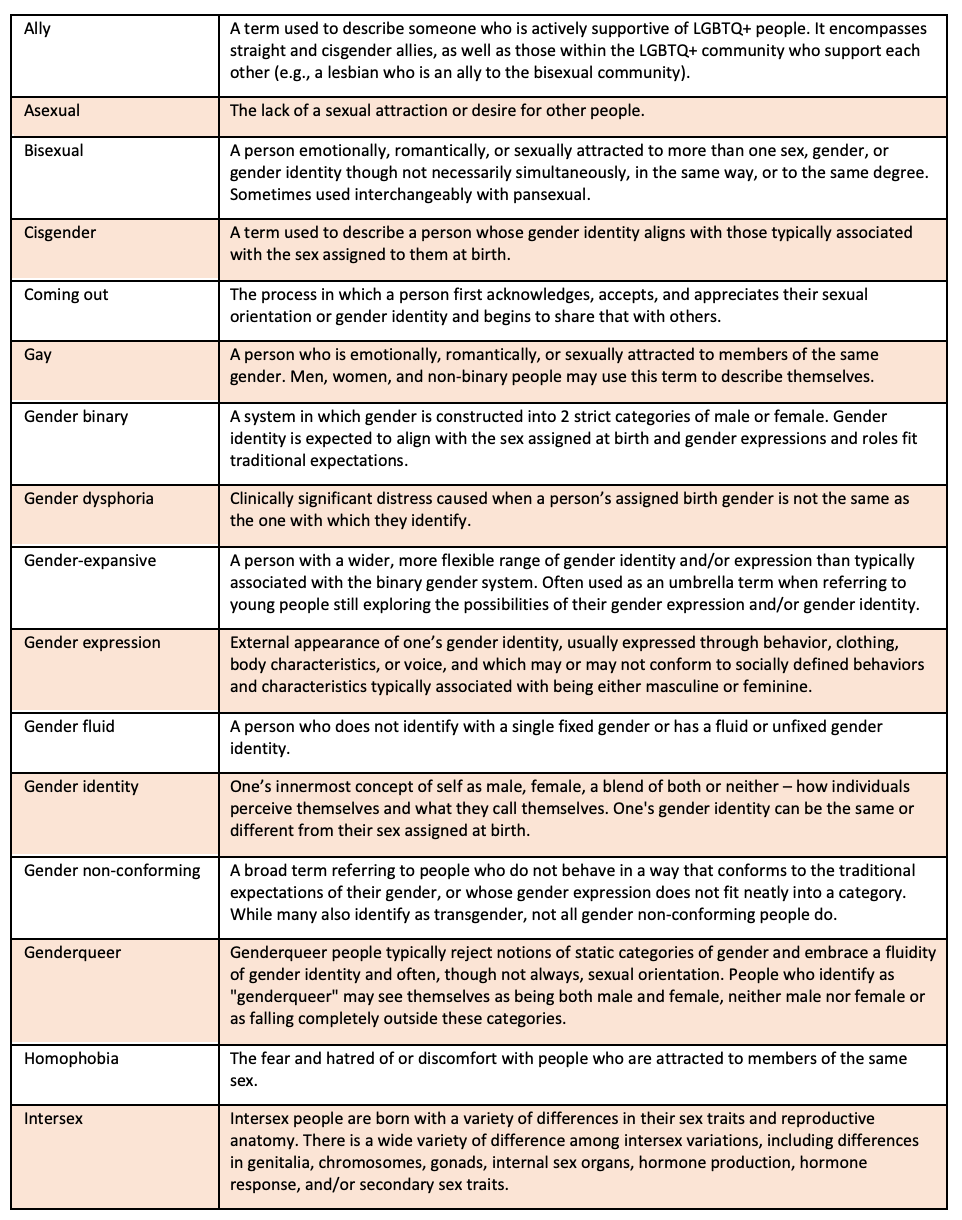
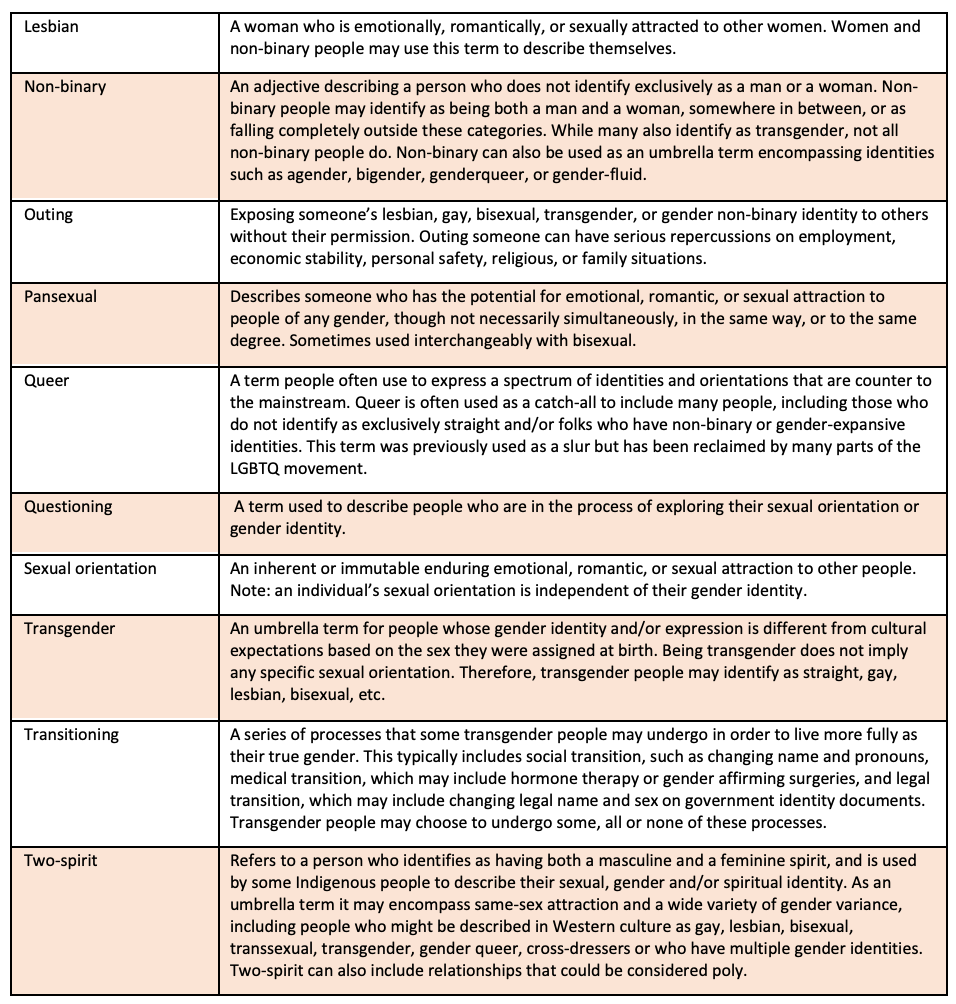
APPENDIX B: Documenting in the Patient Profile
The sex selection should be reserved for sex assigned at birth or designated sex at birth and not be conflated with gender, as one's gender identity can be the same or different from their sex assigned at birth.
When documenting in the patient profile, make this consistent with all patients, not just ones you suspect or know are part of the LGBTQ+ community. This information should be updated as frequently as other demographic information is and located in a consistent manner that is easily accessible.
1. Gender

2. Preferred names
3. Preferred pronouns
4. Family dynamic
APPENDIX C: Pronouns and Communication Basics
A pronoun is a word that takes the place of a noun such as someone’s name. Pronouns can do all the things that nouns can do. They can be subjects, direct objects, indirect objects, object of the preposition, and more. The most used pronouns (he/she) specifically refer to a person’s gender. For the LGBTQ+ community, these pronouns may not fit, and can create discomfort, stress, and anxiety.
Pronouns

Communication Basics
- These guidelines should be followed for all patients, not just those you think or know are part of the LGBTQ+ community. Otherwise, this can seem offensive.
- Do not assume sexual orientation or gender identity based on how a person expresses who they are (how they dress, talk, or act).
- Assess your level of openness and self-acceptance.
- Be aware that a person may disclose their sexual orientation but may not be out to other people. Do not disclose someone else’s sexual orientation to anyone else, including other members of the team, unless that piece of information about the patient is needed for care.
- Ask permission from the patient before you advocate for them. This speaks to outing the person and takes away their power to advocate for themselves.
- Be an ally for all LGBTQ+ people. Stop homophobic, biphobic, and transphobic remarks, jokes, and conversations from the start. Report unacceptable language and behavior to supervisors.
- Use the same language as the patient to describe their identity, their condition, or how they refer to a situation. If you are unsure of a term used, ask!
- There are differences to understand about our patients and it is good to ask about:
- legal names and chosen names;
- sex assigned at birth (needed for insurance claims) and gender identity;
- partner information; and
- sexual orientation.
- Only collect this information if it is important to treatment.
- Opening language to use:
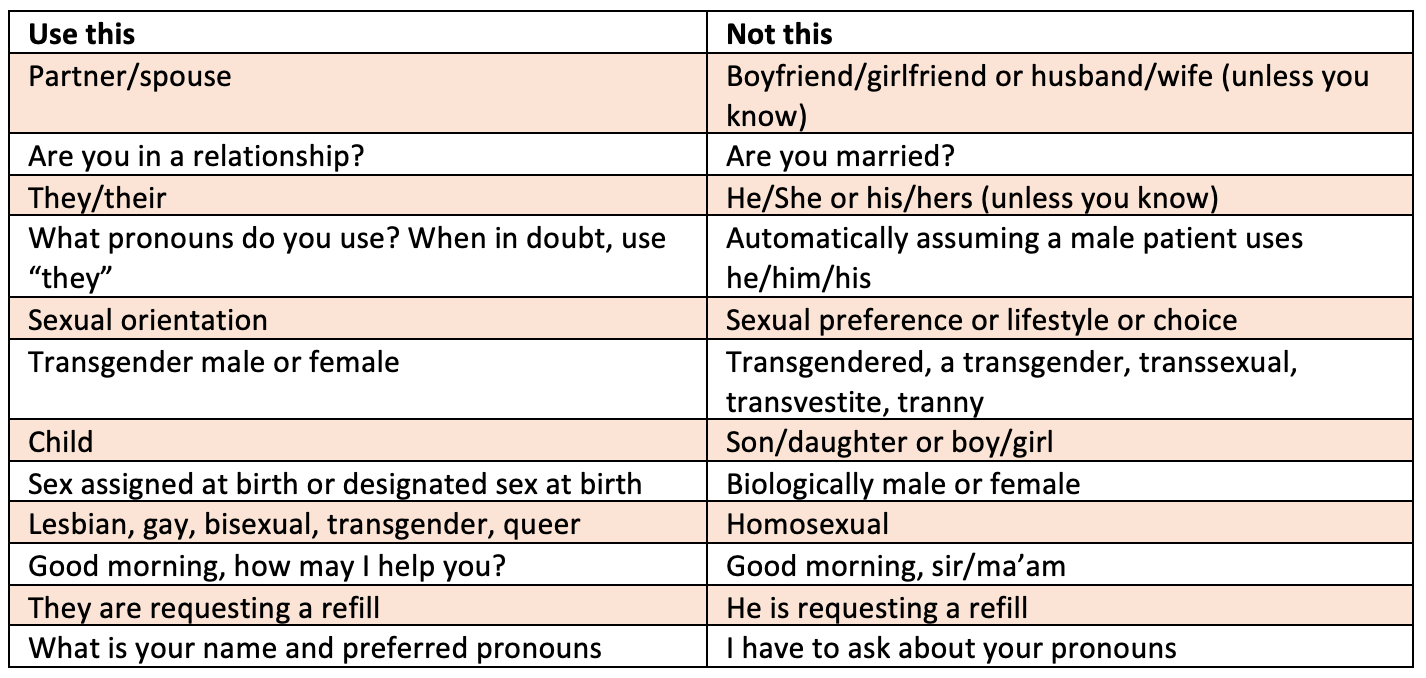
10. Unacceptable language:

11. Most importantly, if you make a mistake, apologize and do better the next time.
Guiding principles from the American Psychiatric Association:
- Gender and sexuality exist in continuums with infinite possibilities.
- The gender and sexuality continuums are separate, yet interrelated realms.
- The gender continuum breaks down into separate—but not mutually exclusive—masculine and feminine continuums.
- Sexuality is composed of 3 distinct realms: orientation and attraction, behavior, and identity. These three realms are interrelated but not always aligned.
- Gender may develop based upon biologic sex, but this is not always the case (ie, transgendered, intersex, androgynous individuals).
- There are biological, psychological, social, and cultural influences at play in gender and sexual developmental trajectories. Social factors, such as family and peer relationships, robustly shape behavior during preschool and school age years.
- Everyone is unique and composed of multiple identities that exist within and interact with other sociocultural realms, such as socioeconomic status, geographic region, race and ethnicity, religious and spiritual affiliation, gender and sexuality among others.
APPENDIX D: Resources for Your Patients
LGBTQ+ Resources
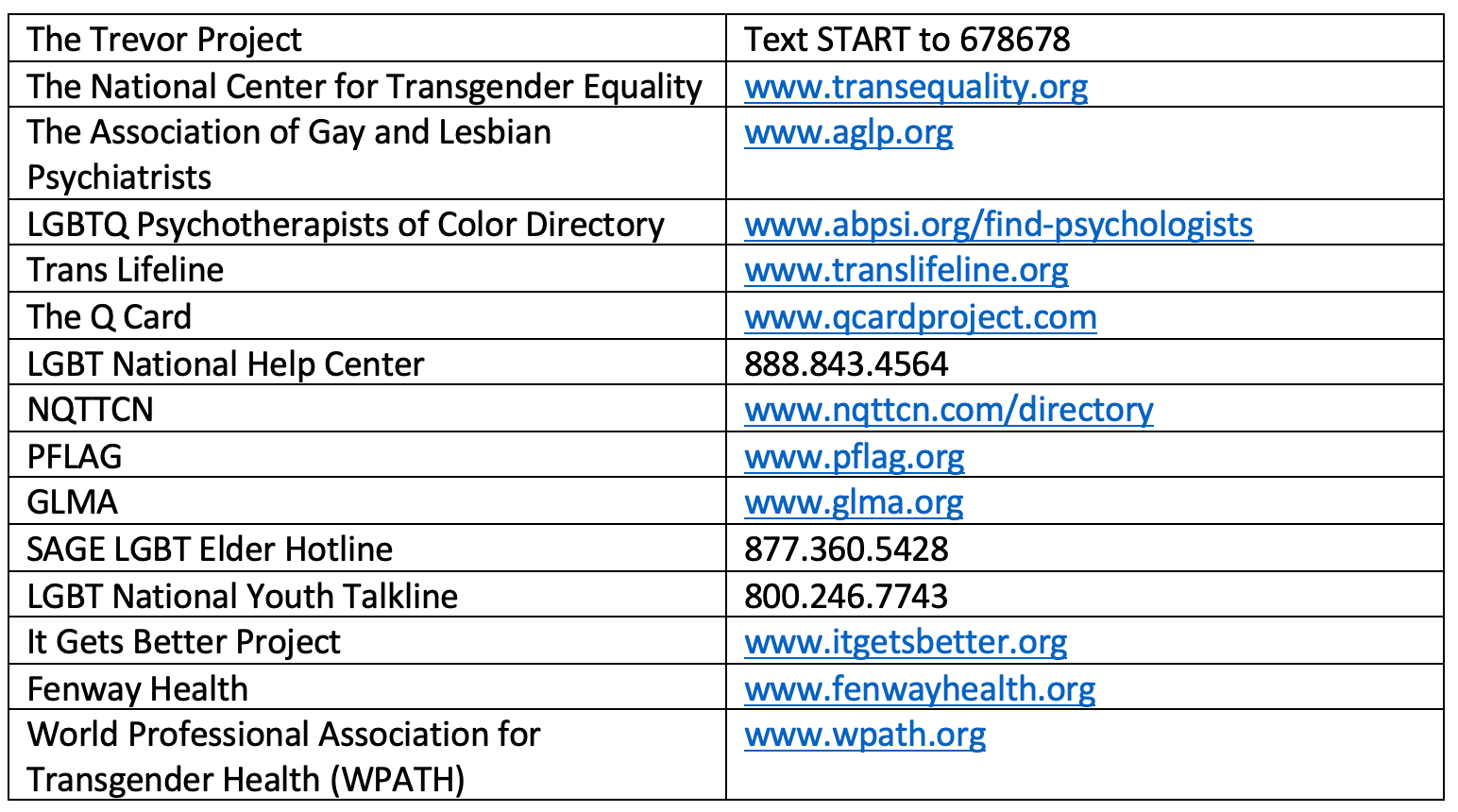
Substance Use Disorder Resources

Latinx Resources
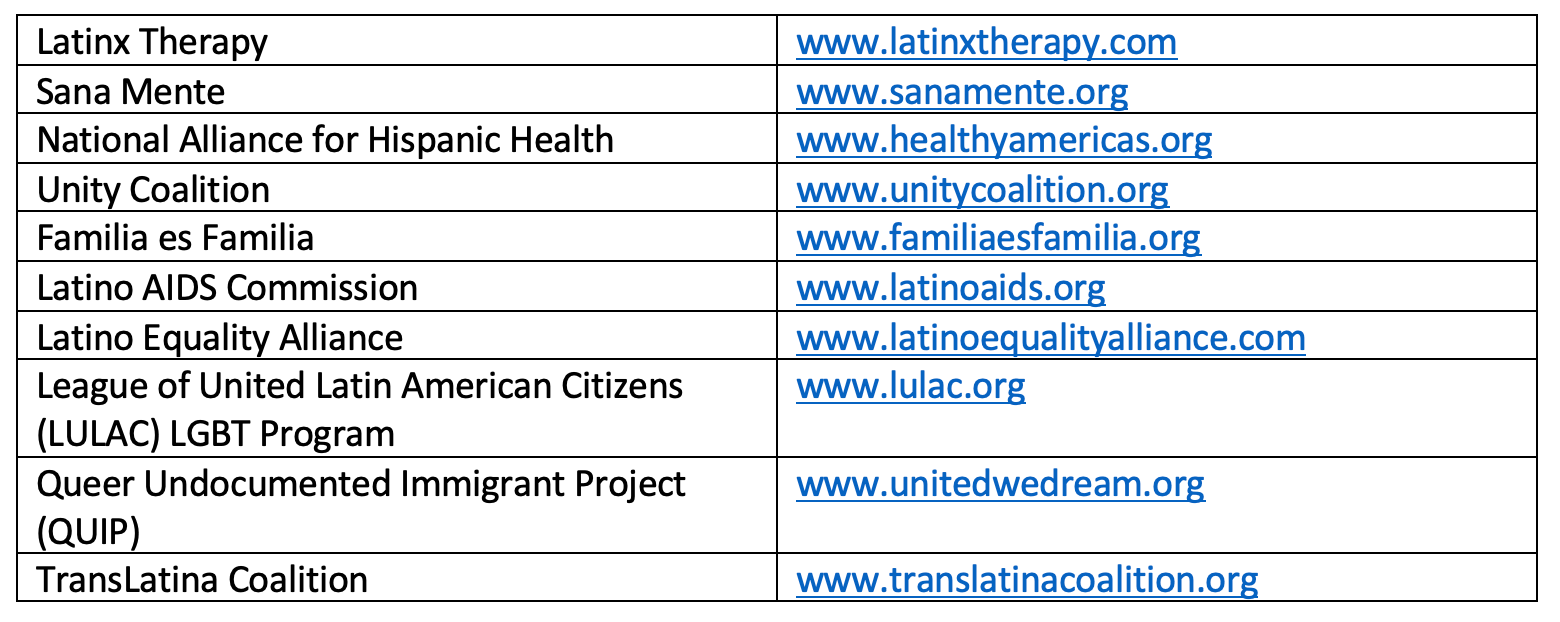
Indigenous Resources

AAPI Resources

African American Resources
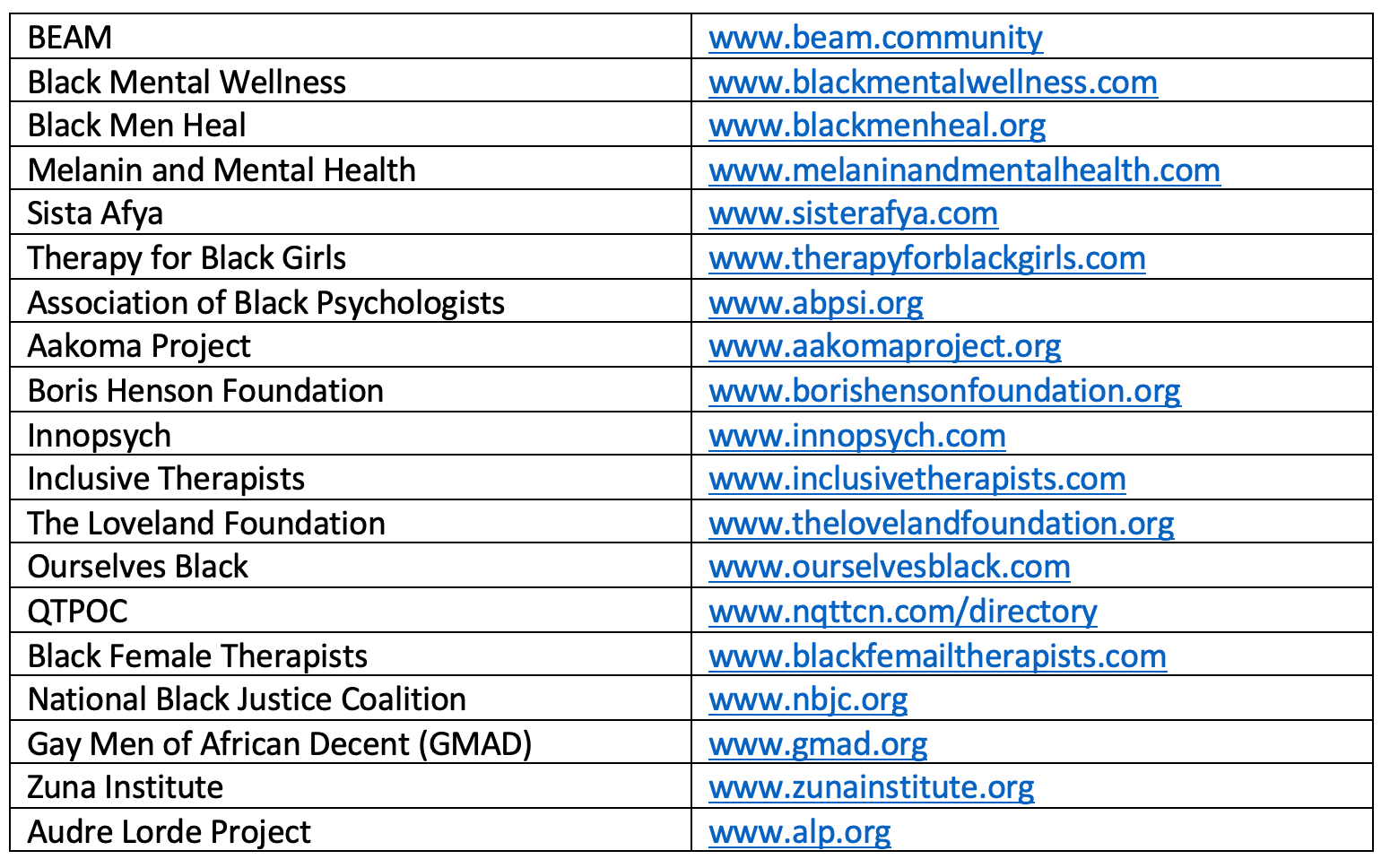
General Mental Health Resources

Anti-Violence and Hate Crimes

Bisexual Resources

Family, Parenting, and Adoption Resources

Immigration Resources

HIV/AIDS Resources
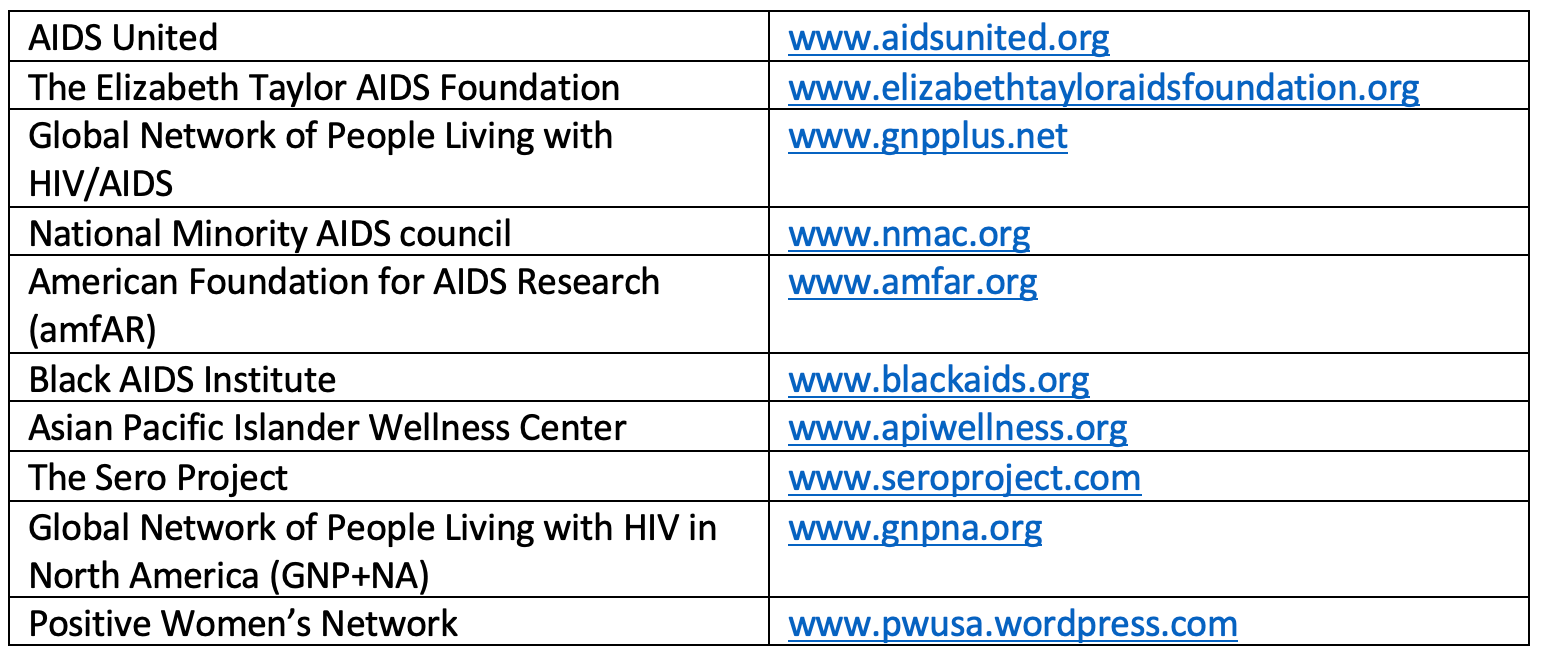
Political Organization Resources

Military Resources

Health Care Professional Resources

QR CODE TO ACCESS THE PATIENT/STAFF RESOURCES
- Diversity and Inclusion posters in full color and black and white, available in 2 sizes
- Pharmacy communication leaflet in color, available as 8.5” x 11”
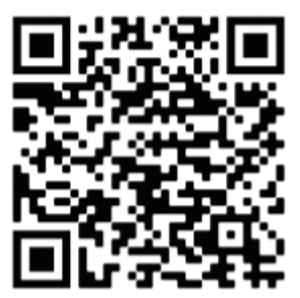
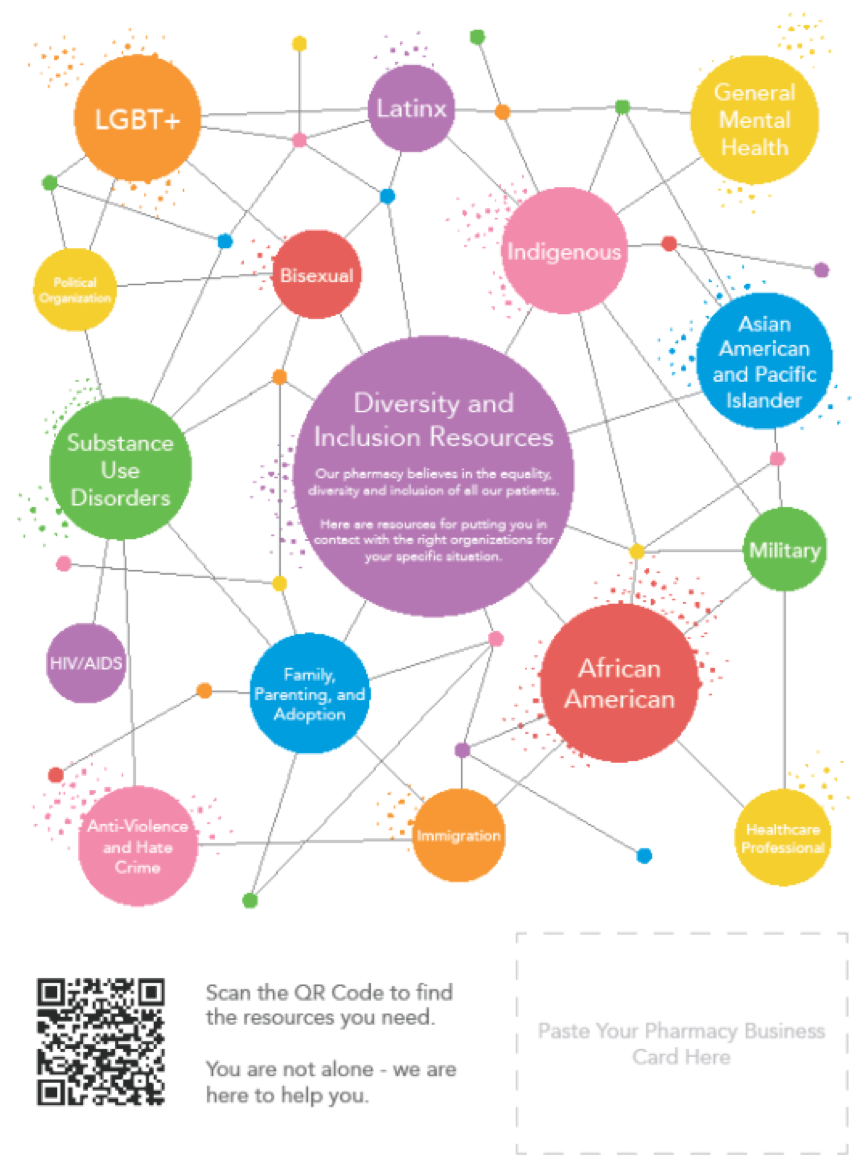
For the full-page poster, use the QR code.
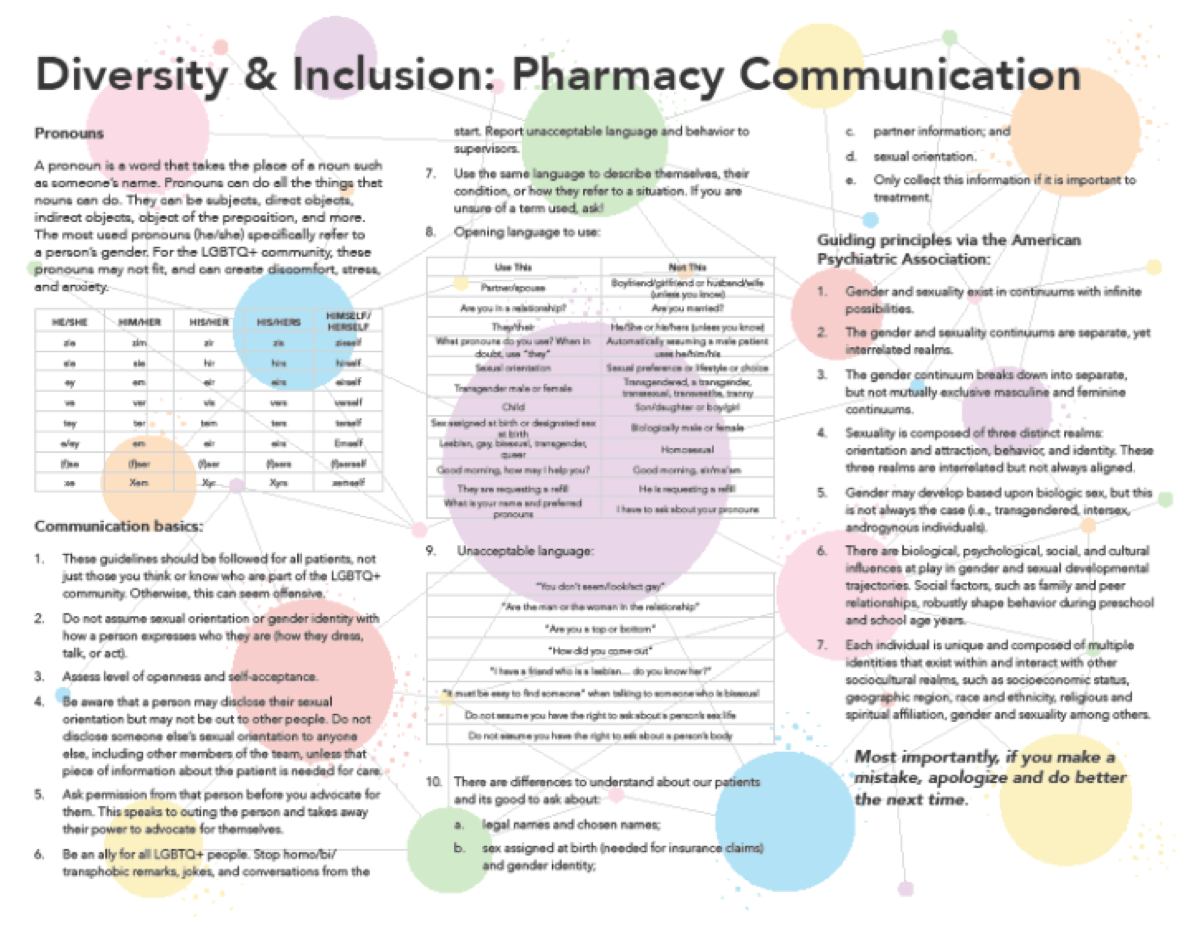
For the full-page leaflet, use the QR code.
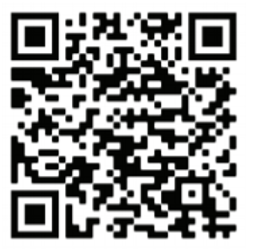
REFERENCES
- Gay and Lesbian Medical Association and LGBT health experts. Healthy People 2010 Companion Document for Lesbian, Gay, Bisexual, and Transgender (LGBT) Health. San Francisco, CA: Gay and Lesbian Medical Association, 2001.
- Lesbian, Gay, Bisexual, and Transgender Health. Office of disease prevention and health promotion. Accessed May 2021. https://www.healthypeople.gov/2020/topics-objectives/topic/lesbian-gay-bisexual-and-transgender-health
- Jann MW, Penzak S, White A, and A Tatachar. An elective course in lesbian, gay, bisexual, and transgender health and practice issues. American Journal of Pharmaceutical Education. October 2019;83(8) 1723-1731.
- Lesbian, Gay, Bisexual, and Transgender Health Workgroup. Office of disease prevention and health promotion. Accessed May 2021. https://health.gov/healthypeople/about/workgroups/lesbian-gay-bisexual-and-transgender-health-workgroup
- Institute of Medicine (US) Committee on Lesbian, Gay, Bisexual, and Transgender Health Issues and Research Gaps and Opportunities. The Health of Lesbian, Gay, Bisexual, and Transgender People: Building a Foundation for Better Understanding. Washington (DC): National Academies Press (US); 2011. 3, Conducting Research on the Health Status of LGBT Populations. Accessed May 2021. https://www.ncbi.nlm.nih.gov/books/NBK64802/
- Conron, K.J., Goldberg, S.K., Adult LGBT Population in the United States. (July 2020). The Williams Institute, UCLA, Los Angeles, CA. Accessed May 2021. https://williamsinstitute.law.ucla.edu/wp-content/uploads/LGBT-Adult-US-Pop-Jul-2020.pdf
- Jones JM. LGBT Identification Rises to 5.6% in Latest U.S. Estimate. Gallop. Accessed May 2021. https://news.gallup.com/poll/329708/lgbt-identification-rises-latest-estimate.aspx
- Gruberg S, Mahowald L, and J Halpin. The state of the LGBTQ community in 2020. Center for American Progress. October 6, 2020. Accessed May 2021. https://www.americanprogress.org/issues/lgbtq-rights/reports/2020/10/06/491052/state-lgbtq-community-2020/
- Fields A. CDC releases report confirming lesbian, gay, and bisexual people at greater risk of COVID-19 illness, calls for more data collection. Human Rights Campaign. February 2021. Accessed May 2021. https://www.hrc.org/press-releases/cdc-releases-report-confirming-lesbian-gay-and-bisexual-people-at-greater-risk-of-covid-19-illness-calls-for-more-data-collection
- Centers for Disease Control and Prevention (CDC). HIV among Gay and Bisexual Men. Atlanta: CDC; Feb 2017. Accessed May 2021. https://www.cdc.gov/nchhstp/newsroom/docs/factsheets/cdc-msm-508.pdf [PDF-78KB]
- Centers for Disease Control and Prevention (CDC). Suicide and violence prevention. Atlanta: CDC; Feb 2016. Accessed May 2021. https://www.cdc.gov/msmhealth/suicide-violence-prevention.htm
- Rooney J. Diverse Universe: Pharmacy schools are taking steps to address cultural competency by preparing future pharmacists to be inclusive and ensure that everyone receives the care they need. American Association of Colleges of Pharmacy. Accessed May 2021. https://www.aacp.org/article/diverse-universe
- LaMonte WW. The Transtheoretical Model (Stages of Change). Boston University School of Public Health. September 2019. Accessed May 2021. https://sphweb.bumc.bu.edu/otlt/mph-modules/sb/behavioralchangetheories/BehavioralChangeTheories6.html
- Hobbis ICA and S Sutton. Are techniques used in cognitive behaviour therapy applicable to behaviour change interventions based on the theory of planned behaviour? Journal of Health Psychology. 2005;10(1): 7-18.
- Luenendonk M. Theory of planned behavior: definition, explained, examples. Cleverism. September 2019. Accessed May 2021. https://www.cleverism.com/theory-of-planned-behavior/#:~:text=The%20Theory%20of%20Planned%20Behavior%20(TPB)%20is%20seen%20as%20an,mentioned%20and%20discussed%20with%20it.&text=The%20TPB%20maintains%20what%20TRA,the%20exercise%20of%20volitional%20control.
- Raypole C. Reviewed by Legg TJ. How cognitive behavioral therapy can rewire your thoughts. Healthline. June 2019. Accessed May 2021. https://www.healthline.com/health/cognitive-behavioral-therapy
- What is cognitive behavioral therapy? American Psychological Association. 2017. Accessed May 2021. https://www.apa.org/ptsd-guideline/patients-and-families/cognitive-behavioral
- Kostick KM, Trejo M, Volk, RJ, et. al. Using nudges to enhance clinicians’ implementation of shared decision making with patient decision aids. MDM Policy & Practice. The Authors. February 2020. 1-13. Accessed May 2021. https://journals.sagepub.com/doi/full/10.1177/2381468320915906
- Zenger J and J Folkman. The trickle-down effect of good (and bad) leadership. Harvard Business Review. January 2016. Accessed May 2021. https://hbr.org/2016/01/the-trickle-down-effect-of-good-and-bad-leadership
- Nudging out the coronavirus with behavioral economics. Stockholm School of Economics. June 2020. Accessed May 2021. https://phys.org/news/2020-06-nudging-coronavirus-behavioral-economics.html#:~:text=Nudge%20theory%20is%20a%20concept,context%20where%20decisions%20are%20made.
- Nudging behaviour. Economic and Social Research Council. Accessed May 2021. https://esrc.ukri.org/about-us/50-years-of-esrc/50-achievements/nudging-behaviour/
- Smith A. Boots tests ‘behavioural nudge theory’ for medication adherence. PharmaTimes online. March 2019. Accessed May 2021. http://www.pharmatimes.com/news/boots_tests_behavioural_nudge_theory_for_medication_adherence_1282881
- Joszt L. Nudging people into health behaviors. AJMC. October 2016. Accessed May 2021. https://www.ajmc.com/view/nudging-people-into-healthy-behaviors
- Leets LL, Cahill J, Sprenger AM, et. al. Nudging discharge readiness with a poster: a sequential, exploratory mixed methods pilot study of patient caregivers. Journal of Patient Experience. The Authors. 2020;7(6) 1341-1448. Accessed May 2021. https://journals.sagepub.com/doi/pdf/10.1177/2374373520968976
- Schwindt RG. LGBTQ cultural competence for pharmacists. PharmacyToday. September 2020. Accessed May 2021. https://www.pharmacytoday.org/article/S1042-0991(20)30876-8/fulltext
- LGBTQ+ cultural awareness and best practices continuing education for pharmacists and pharmacy technicians. Power-Pak C.E. Accessed May 2021. https://www.powerpak.com/course/content/118679
- Providing LGBTQ-inclusive care and services at your pharmacy: a resource guide for pharmacists and pharmacy staff. Human Rights Campaign Foundation. June 2016. Accessed May 2021. https://www.thehrcfoundation.org/professional-resources/providing-lgbtq-inclusive-care-and-services-at-your-pharmacy
- Taylor J. How leaders can create an LGBTQ-inclusive workplace. Launchways. July 2019. Accessed May 2021. https://www.launchways.com/lgbtq-inclusive-workplace/
- Dupreelle P, Lindquist J, Micon N, et. al. A new LGBTQ workforce has arrived – inclusive cultures must follow. BCG. June 2020. Accessed May 2021. https://www.bcg.com/publications/2020/inclusive-cultures-must-follow-new-lgbtq-workforce
- Poirier JM, Fisher SK, Hunt RA, and M Bearse. A guide for understanding, supporting, and affirming LGBTQI2-S children, youth, and families. American Institutes for Research. 2014. Accessed May 2021. https://www.socialworkers.org/LinkClick.aspx?fileticket=jjq0-NcZlU0%3D&portalid=0
- Chapter 3: the coming out experience. A survey of LGBT Americans. Pew Research Center. June 2013. Accessed May 2021. https://www.pewresearch.org/social-trends/2013/06/13/chapter-3-the-coming-out-experience/
- Kurter HL. Here are 4 ways companies can make workplaces more LGBTQ inclusive. Forbes. October 2020. Accessed May 2021. https://www.forbes.com/sites/heidilynnekurter/2020/10/18/here-are-4-ways-companies-can-make-workplaces-more-lgbtq-inclusive/?sh=3fb4883262a3
- Burt E. Nudge theory can help change your employees' behaviour (without them even realising). People Management. March 2019. Accessed May 2021. https://www.peoplemanagement.co.uk/long-reads/articles/nudge-theory-change-employees-behaviour-without-realising#gref
- Mirza AM and C Rooney. Discrimination prevents LGBTQ people from accessing health care. Center for American Progress. January 2018. Accessed May 2021. https://www.americanprogress.org/issues/lgbtq-rights/news/2018/01/18/445130/discrimination-prevents-lgbtq-people-accessing-health-care/
Newsletter
Stay informed on drug updates, treatment guidelines, and pharmacy practice trends—subscribe to Pharmacy Times for weekly clinical insights.





